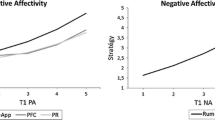Abstract
Two correlational studies that investigated the “specificity” and “generality” hypotheses of cognitive-affective interaction are reported. Nonpsychiatric individuals were administered a questionnaire designed to assess the subjective experience of representative anxious and depressive thoughts across five parameters: frequency, sadness, worry, dismissal, and unacceptability. Thoughts of loss and failure evidenced a specific relation with self-reported depressed mood while, to a lesser extent, cognitions of harm and danger demonstrated their strongest association with anxiety. Presence of mild dysphoria was significantly and reliably predicted by cognitive factors. In addition to supporting Beck's cognitive theory of emotion, the results also suggest a number of variables that are influential in determining the strength of association between affect and cognition.
Similar content being viewed by others
References
Beck, A. (1976).Cognitive therapy and the emotional disorders. New York: New American Library.
Beck, A. (1985). Part I. Theoretical and clinical aspects. In A. Beck, G. Emery, & R. Greenberg,Anxiety disorders and phobias: A cognitive perspective. New York: Basic Books.
Beck, A., Laude, R., & Bohnert, M. (1974). Ideational components of anxiety neurosis.Archives of General Psychiatry, 31 319–325.
Beck, A., Rush, A., Shaw, B., & Emery, G. (1979).Cognitive therapy of depression. New York: Guilford Press.
Beck, A., Ward, C., Mendelson, M., Mock, J., & Erbaugh, J. (1961). An inventory for measuring depression.Archives of General Psychiatry, 4 53–63.
Borkovec, T., Robinson, E., Pruzinsky, T., & DePree, J. (1983). Prelinimary exploration of worry: Some characteristics and processes.Behaviour Research and Therapy, 21 9–16.
Bumberry, W., Oliver, J., & McClure, J. (1978). Validation of the Beck Depression Inventory in a university population using psychiatric estimate as the criterion.Journal of Consulting and Clinical Psychology, 46 150–155.
Clark, D. A. (1985).Self-reported emotional and physiological responses to anxious and depressive cognitions. Unpublished manuscript.
Clark, D. A. (1986). Factors influencing the retrieval and control of negative cognitions.Behaviour Research and Therapy, 24 151–159.
Clark, D. A., & de Silva, P. (1985). The nature of depressive and anxious, intrusive thoughts: Distinct or uniform phenomena?Behaviour Research and Therapy, 23 383–393.
Clark, D. A., & Hemsley, D. (1985). Individual differences in the experience of depressive and anxious, intrusive thoughts.Behaviour Research and Therapy, 23 625–633.
Dobson, K., & Breiter, H. (1983). Cognitive assessment of depression: Reliability and validity of three measures.Journal of Abnormal Psychology, 92 107–109.
Ellis, A. (1977). The basic clinical theory of rational-emotive therapy. In A. Ellis & R. Grieger (Eds.),Handbook of rational-emotive therapy. New York: Springer.
Hammen, C. (1981). Assessment: A clinical and cognitive emphasis. In L. Rehm (Ed.),Behaviour therapy for depression: Present status and future directions. New York: Academic Press.
Hand, D. (1981).Discrimination and classification. Chichester, England: Wiley.
Harrell, T., Chambless, D., & Calhoun, J. (1981). Correlational relationships between self-statements and affective states.Cognitive Therapy and Research, 5 159–173.
Hollon, S., & Kendall, P. (1980). Cognitive self-statements in depression: Development of an Automatic Thoughts Questionnaire.Cognitive Therapy and Research, 4 383–395.
Horowitz, M. (1975). Intrusive and repetitive thoughts after experimental stress.Archives of General Psychiatry, 32 1457–1463.
Howarth, E., & Schokman-Gates, K. (1981). Self-report multiple mood instruments.British Journal of Psychology, 72 421–441.
Huberty, C. (1984). Issues in the use of interpretation of discriminant analysis.Psychological Bulletin, 95 156–171.
Johnston, M., & Hackmann, A. (1977). Cross-validation and response sets in repeated use of mood questionnaires.British Journal of Social and Clinical Psychology, 16 235–239.
LaPointe, K., & Harrell, T. (1978). Thoughts and feelings: Correlational relationships and cross-situational consistency.Cognitive Therapy and Research, 2 311–322.
Metcalfe, M., & Goldman, E. (1965). Validation of an inventory for measuring depression.British Journal of Psychiatry, 111 240–242.
Parkinson, L., & Rachman, S. (1981a). Part II. The nature of intrusive thoughts.Advances in Behaviour Research and Therapy, 3 101–110.
Parkinson, L., & Rachman, S. (1981b). Part III. Intrusive thoughts: The effects of an uncontrived stress.Advances in Behaviour Research and Therapy, 3 111–118.
Rachman, S., & de Silva, P. (1978). Abnormal and normal obsessions.Behaviour Research and Therapy, 16 233–248.
Sewitch, T., & Kirsch, I. (1984). The cognitive content of anxiety: Naturalistic evidence for the predominance of threat-related thoughts.Cognitive Therapy and Research, 8 49–58.
Strober, M., Green, J., & Carlson, G. (1981). Utility of the Beck Depression Inventory with psychiatrically hospitalized adolescents.Journal of Consulting and Clinical Psychology, 49 482–483.
Tabachnick, B., & Fidell, L. (1983).Using multivariate statistics. New York: Harper & Row.
Thorpe, G., Barnes, G., Hunter, J., & Hines, D. (1983). Thoughts and feelings: Correlations in two clinical and two nonclinical samples.Cognitive Therapy and Research, 7 565–574.
Zuckerman, M., & Lubin, B. (1965).Manual for the Multiple Affect Adjective Checklist. San Diego: Edits Publishers.
Author information
Authors and Affiliations
Additional information
During the course of the research the author obtained support from the ORS Award Scheme of the Committee of Vice-Chancellors and Principals of the Universities of the United Kingdom and a sponsorship from the Department of Health, Providence of New Brunswick, Canada. The research was conducted as part of the doctoral dissertion requirements of the University of London. I gratefully acknowledge the assistance of David Hemsley and Padmal de Silva, who supervised the research; David Hand, who provided statistical advice; and Aaron T. Beck, David Hemsley, Shelley Channon, and an anonymous reviewer, who offered very helpful comments on an earlier draft of this manuscript.
Rights and permissions
About this article
Cite this article
Clark, D.A. Cognitive-affective interaction: A test of the “specificity” and “generality” hypotheses. Cogn Ther Res 10, 607–623 (1986). https://doi.org/10.1007/BF01173749
Issue Date:
DOI: https://doi.org/10.1007/BF01173749




